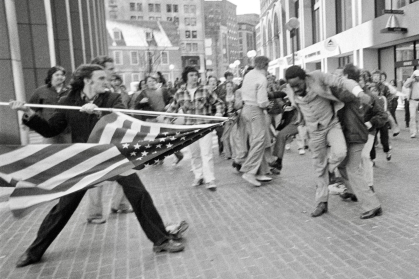Revisiting The Soiling of Old Glory, an Iconic Image of the Civil Rights Movement

Nearly 50 years ago during a protest against Boston’s plan to desegregate its public schools, newspaper photographer Stanley Forman snapped a picture that came to symbolize the country’s racial division. The image depicting a white protester using an American flag to attack a Black man taken on April 5, 1976, ran in newspapers nationwide and later won a Pulitzer Prize.
In his book The Soiling of Old Glory: The Story of a Photograph That Shocked America, Louis P. Masur, Rutgers Distinguished Professor of American studies and history, delved into the stories behind the picture, the day’s event leading up to that moment and the people depicted in the photo, their lives before and after the shot.
Masur’s book, originally published in 2008, was recently re-released with a new foreword written by attorney Ted Landsmark, the Black man in the photo. Masur, Landsmark and Forman will come together on April 11 for a virtual and in-person panel discussion in Boston on the book that provides dramatic window into the turbulence of the 1970s and race relations in America.
As the anniversary of the event approaches, Masur talked to Rutgers Today about why it was time to revisit the iconic photo.
Why is the book back in print now? Why re-live the moment now?
Brandeis University Press decided to bring the book back in a paperback edition because the topic is as timely as ever. The problem of racial violence has exploded nationally in the past decade, and Stanley Forman’s photograph remains an iconic image and a touchstone for discussions of race and the meaning of America.
What does the photo tell us about that moment in American history?
The photo was taken in 1976, in Boston. It was the Bicentennial, and yet here was a shocking act of racial violence that occurred, not in the deep South, but in New England. The photo speaks to that moment while, at the same time, it speaks generally to American history – to the struggle for civil rights, to the meaning of the flag, to a history of fear and violence.
Why did you invite Ted Landsmark to write the foreword now and why did he agree?
Ted is a remarkable person and nearly 50 years after the incident I hoped that he might want to address the issues of racial and social justice to which he has devoted much of his incredible career. He did not allow that moment, attacked by a protester wielding the American flag, to define him or the city. As he says in the foreword, the photo documented racism in action. Racism is rarely displayed that way and, as he points out, it tends to lurk subtly in workplaces, families, and social settings. I think he agreed to write the foreword because he saw it as an opportunity to continue the dialogue about how to overcome racism and build toward the future.
Why do you think the photo had such a lasting impact on you and others?
There are any number of photographs that have changed history. Think of Joe Rosenthal’s Flag-Raising on Iwo Jima during World War II or Nick Ut’s Napalm Girl photo taken during the Vietnam War. I devote much of the book to unpacking why the photo is so powerful. I was in college when I first saw it and never forgot it. The image is felt as much as seen, a moment of suspended animation that makes one wonder what is happening and what will the outcome be? I see my book, in part, as an exercise in visual literacy, in learning how to read a photograph.
Why did you finally decide to explore its history and the people behind the photo?
There are multiple stories here. I couldn’t write about the story of the photograph without also telling the story of Stanley Forman, the photographer, Ted Landsmark, the victim, and Joseph Rakes, the student with the flag. There are other stories as well that, as an historian, I felt compelled to explore, whether the history of busing or the idea that Boston somehow was a racist city.
What kinds of conversations are you hoping to spark with the re-release to your book?
Ted ends his foreword with the hope the book will spark meaningful conversations about race that might lead to Americans supporting each other “more equitably and justly.” I share that hope. There is another, different conversation too that is timely – a conversation about the role of photographs in society, especially at this moment where AI can produce images that are entirely fake. Photographs are as influential as ever, and perhaps more ubiquitous. It is all the more important we take a methodical approach to reading and understanding them.
To attend the April 11 panel discussion virtually, register here with WGBH for the Zoom link.


